1、I/O 模型简单的理解:就是用什么样的通道进行数据的发送和接收,很大程度上决定了程序通信的性能
2、Java 共支持 3 种网络编程模型/IO 模式:BIO、NIO、AIO
3、Java BIO : 同步并阻塞(传统阻塞型),服务器实现模式为一个连接一个线程,即客户端有连接请求时服务器端就需要启动一个线程进行处理,如果这个连接不做任何事情会造成不必要的线程开销

4、Java NIO :
同步非阻塞,服务器实现模式为一个线程处理多个请求(连接),即客户端发送的连接请求都会注册到多路复用器上,多路复用器轮询到连接有 I/O 请求就进行处理
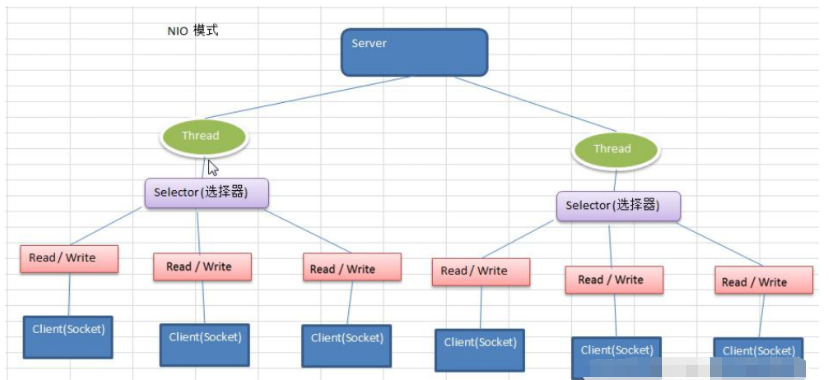
5、Java AIO(NIO.2) :
异步非阻塞,AIO 引入异步通道的概念,采用了 Proactor 模式,简化了程序编写,有效的请求才启动线程,它的特点是先由操作系统完成后才通知服务端程序启动线程去处理,一般适用于连接数较多且连接时间较长的应用
BIO :特点:同步并阻塞;使用场景:一个连接对应一个线程 2.线程开销大 连接数目比较小且固定的架构,服务器资源要求比较高,程序简单易理解
NIO :特点:同步非阻塞;使用场景:一个线程处理多个请求(连接) 2.多路复用器轮询到连接有 I/O 请求 连接数目多且连接比较短(轻操作),比如聊天服务器,弹幕系统,服务器间通讯等。编程比较复杂
AIO :特点:异步非阻塞;使用场景:采用了 Proactor 模式 连接数较多且连接时间较长,比如相册服务器,充分调用 OS 参与并发操作,编程比较复杂
- Java BIO 就是传统的 java io 编程,其相关的类和接口在 java.io
- BIO(blocking I/O): 同步阻塞,服务器实现模式为一个连接一个线程,即客户端有连接请求时服务器端就需要启动一个线程进行处理,如果这个连接不做任何事情会造成不必要的线程开销,可以通过线程池机制改善(实现多个客户连接服务器)。
- BIO 方式适用于连接数目比较小且固定的架构,这种方式对服务器资源要求比较高,并发局限于应用中,JDK1.4以前的唯一选择,程序简单易理解

BIO 编程流程的梳理:
服务器端启动一个 ServerSocket
客户端启动 Socket 对服务器进行通信,默认情况下服务器端需要对每个客户建立一个线程与之通讯
客户端发出请求后, 先咨询服务器是否有线程响应,如果没有则会等待,或者被拒绝
如果有响应,客户端线程会等待请求结束后,在继续执行
实例说明:
- 使用 BIO 模型编写一个服务器端,监听 6666 端口,当有客户端连接时,就启动一个线程与之通讯。
- 要求使用线程池机制改善,可以连接多个客户端.
- 服务器端可以接收客户端发送的数据(telnet 方式即可)。


package com.sun.bio; import java.io.IOException; import java.io.InputStream; import java.net.ServerSocket; import java.net.Socket; import java.util.concurrent.ExecutorService; import java.util.concurrent.Executors; /** * @Author: sunguoqiang * @Description: TODO * @DateTime: 2022/12/20 10:49 **/ public class BioServer { public static void main(String[] args) throws Exception { // 1、创建线程池,为多个客户端提供线程处理请求 ExecutorService executorService = Executors.newCachedThreadPool(); // 2、创建socket服务器,绑定端口9999 ServerSocket serverSocket = new ServerSocket(9999); // 3、循环接收客户端请求 while (true) { // 4、接收客户端请求,获取请求的客户端 Socket acceptSocket = serverSocket.accept(); // 5、线程池处理请求 executorService.submit(() -> { handle(acceptSocket); }); } } // 6、处理请求的方法 private static void handle(Socket socket) { System.out.println("处理当前请求的线程ID:" + Thread.currentThread().getId()); InputStream inputStream = null; byte[] bytes = new byte[1024]; try { inputStream = socket.getInputStream(); while (true) { int read = inputStream.read(bytes); if (read != -1) { System.out.println("线程ID[" + Thread.currentThread().getId() + "]接收到的数据:" + new String(bytes, 0, read)); } else { break; } } } catch (Exception e) { e.printStackTrace(); }finally { try { inputStream.close(); socket.close(); } catch (IOException e) { e.printStackTrace(); } } } }复制
- 每个请求都需要创建独立的线程,与对应的客户端进行数据 Read,业务处理,数据 Write 。
- 当并发数较大时,需要创建大量线程来处理连接,系统资源占用较大。
- 连接建立后,如果当前线程暂时没有数据可读,则线程就阻塞在 Read 操作上,造成线程资源浪费
Java NIO 全称 java non-blocking IO,是指 JDK 提供的新 API。从 JDK1.4 开始,Java 提供了一系列改进的输入/输出的新特性,被统称为 NIO(即 New IO),是同步非阻塞的
NIO 相关类都被放在 java.nio 包及子包下,并且对原 java.io 包中的很多类进行改写。
NIO 有三大核心部分:Channel( 通道),Buffer( 缓冲区), Selector( 选择器)
NIO 是区面向缓冲区,向或者面向块编程的。数据读取到一个它稍后处理的缓冲区,需要时可在缓冲区中前后移动,这就增加了处理过程中的灵活性,使用它可以提供非阻塞式的高伸缩性网络
Java NIO 的非阻塞模式,使一个线程从某通道发送请求或者读取数据,但是它仅能得到目前可用的数据,如果目前没有数据可用时,就什么都不会获取,而不是保持线程阻塞,所以直至数据变的可以读取之前,该线程可以继续做其他的事情。非阻塞写也是如此,一个线程请求写入一些数据到某通道,但不需要等待它完全写入,这个线程同时可以去做别的事情。
通俗理解:NIO 是可以做到用一个线程来处理多个操作的。 假设有 10000 个请求过来,根据实际情况,可以分配50 或者 100 个线程来处理。不像之前的阻塞 IO 那样,非得分配 10000 个。
HTTP2.0 使用了多路复用的技术,做到同一个连接并发处理多个请求,而且并发请求的数量比 HTTP1.1 大了好几个数量级
案例说明 NIO 的 Buffer


package com.sun.netty.Buffer; import java.nio.IntBuffer; /** * @Author: sunguoqiang * @Description: TODO * @DateTime: 2022/12/20 11:29 **/ public class BasicBuffer { public static void main(String[] args) { // 1、创建一个存储int类型数据的Buffer,存储容量为5 IntBuffer intBuffer = IntBuffer.allocate(5); // 2、向Buffer中添加数据 for (int i = 0; i < intBuffer.capacity(); i++) { intBuffer.put(i*2); } // 3、如何从Buffer中读取数据? // 3.1、读写转换操作,必须做 intBuffer.flip(); // 4、正式读取 while(intBuffer.hasRemaining()){ System.out.println(intBuffer.get()); } } }复制
1、BIO 以流的方式处理数据,而 NIO 以块的方式处理数据,块 I/O 的效率比流 I/O 高很多
2、BIO 是阻塞的,NIO 则是非阻塞的
3、BIO 基于字节流和字符流进行操作,而 NIO 基于 Channel(通道)和 Buffer(缓冲区)进行操作,数据总是从通道读取到缓冲区中,或者从缓冲区写入到通道中。Selector(选择器)用于监听多个通道的事件(比如:连接请求,数据到达等),因此使用单个线程就可以 监听多个客户端通道
关系图的说明:
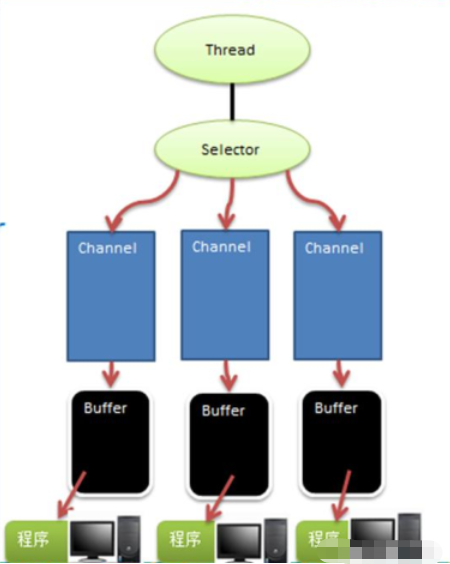
- 每个 channel 都会对应一个 Buffer
- Selector 对应一个线程, 一个线程对应多个 channel(连接)
- 该图反应了有三个 channel 注册到 该 selector //程序
- 程序切换到哪个 channel 是有事件决定的, Event 就是一个重要的概念
- Selector 会根据不同的事件,在各个通道上切换
- Buffer 就是一个内存块 , 底层是有一个数组
- 数据的读取写入是通过 Buffer, 这个和 BIO , BIO 中要么是输入流,或者是输出流, 不能双向,但是 NIO 的 Buffer 是可以读也可以写, 需要 flip 方法切换channel 是双向的, 可以返回底层操作系统的情况, 比如 Linux , 底层的操作系统通道就是双向的.
缓冲区(Buffer):
缓冲区本质上是一个可以读写数据的内存块,可以理解成是一个容器对象( 含数组),该对象提供了一组方法,可以更轻松地使用内存块,,缓冲区对象内置了一些机制,能够跟踪和记录缓冲区的状态变化情况。Channel 提供从文件、网络读取数据的渠道,但是读取或写入的数据都必须经由 Buffer.
1、在 NIO 中,Buffer 是一个顶层父类,它是一个抽象类, 类的层级关系图:

2、Buffer 类定义了所有的缓冲区都具有的四个属性来提供关于其所包含的数据元素的信息:

3、Buffer 类相关方法一览
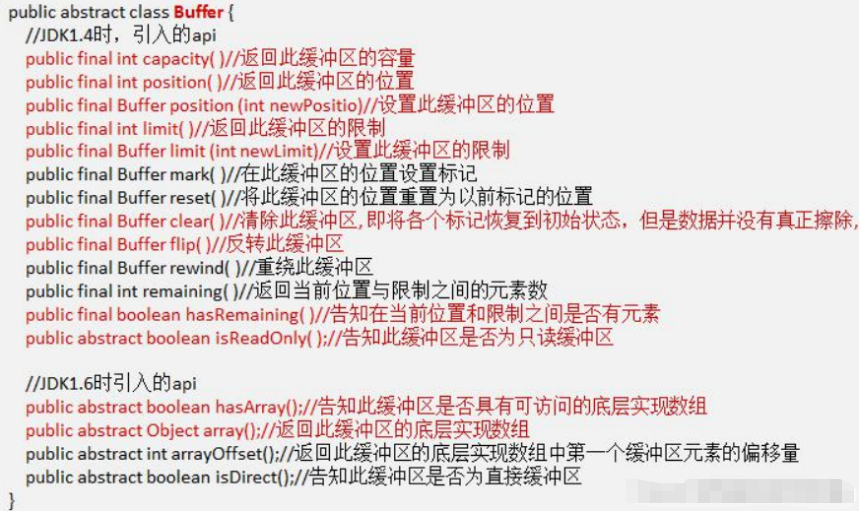

从前面可以看出对于 Java 中的基本数据类型(boolean 除外),都有一个 Buffer 类型与之相对应,最常用的自然是 ByteBuffer 类(二进制数据),该类的主要方法如下:
1、NIO 的通道类似于流,但有些区别如下:
- 通道可以
同时进行读写,而流只能读或者只能写- 通道可以实现
异步读写数据- 通道可以
从缓冲读数据,也可以写数据到缓冲:
2、BIO 中的 stream 是单向的,例如 FileInputStream 对象只能进行读取数据的操作,而 NIO 中的通道(Channel)是双向的,可以读操作,也可以写操作。
3、Channel 在 NIO 中是一个接口 public interface Channel extends Closeable{}
4、常用的Channel 类有 :
- FileChannel
- DatagramChannel
- ServerSocketChannel
- SocketChannel
【ServerSocketChanne 类似 ServerSocket , SocketChannel 类似 Socket】
5、FileChannel 用于文件的数据读写,DatagramChannel 用于 UDP 的数据读写,ServerSocketChannel 和SocketChannel 用于 TCP 的数据读写。
6、图示
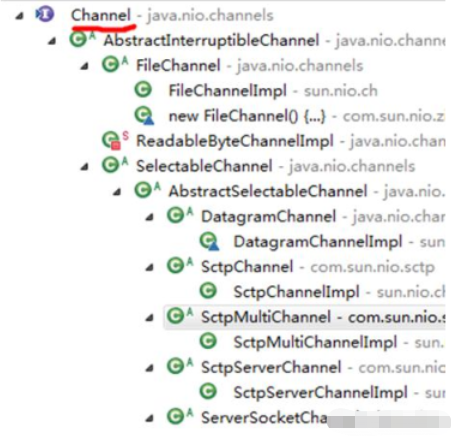
FileChannel 主要用来对本地文件进行 IO 操作,常见的方法有
public int read(ByteBuffer dst) ,从通道读取数据并放到缓冲区中
public int write(ByteBuffer src) ,把缓冲区的数据写到通道中
public long transferFrom(ReadableByteChannel src, long position, long count),从目标通道中复制数据到当前通道
public long transferTo(long position, long count, WritableByteChannel target),把数据从当前通道复制给目标通道


package com.sun.netty.Buffer; import java.io.FileNotFoundException; import java.io.FileOutputStream; import java.nio.ByteBuffer; import java.nio.channels.FileChannel; import java.nio.charset.StandardCharsets; /** * @Author: sunguoqiang * @Description: TODO * @DateTime: 2022/12/21 9:30 **/ public class FileChannel01 { public static void main(String[] args) throws Exception { String str="hello,你好!"; // 1、创建文件输出流 FileOutputStream fileOutputStream = new FileOutputStream("1.txt"); // 2、根据文件输出流获取channel FileChannel channel = fileOutputStream.getChannel(); // 3、定义Buffer ByteBuffer byteBuffer = ByteBuffer.allocate(1024); // 4、将数据放入缓冲区Buffer byteBuffer.put(str.getBytes(StandardCharsets.UTF_8)); // 5、切记!!!Buffer读写转换 byteBuffer.flip(); // 5、将缓冲区数据写入管道channel channel.write(byteBuffer); // 6、关闭资源 fileOutputStream.close(); } }复制


package com.sun.netty.Buffer; import java.io.FileInputStream; import java.io.FileNotFoundException; import java.nio.ByteBuffer; import java.nio.channels.FileChannel; /** * @Author: sunguoqiang * @Description: TODO * @DateTime: 2022/12/21 9:44 **/ public class FileChannel02 { public static void main(String[] args) throws Exception { // 1、获取文件输入流 FileInputStream fileInputStream = new FileInputStream("1.txt"); // 2、通过文件输入流获取channel FileChannel channel = fileInputStream.getChannel(); // 3、创建Buffer ByteBuffer byteBuffer = ByteBuffer.allocate(1024); // 4、将文件从管道读取到缓存中 int read = channel.read(byteBuffer); // 5、输出读取文本 System.out.println(new String(byteBuffer.array(),0,read)); // 6、关闭资源 fileInputStream.close(); } }复制


package com.sun.netty.Buffer; import java.io.FileInputStream; import java.io.FileNotFoundException; import java.io.FileOutputStream; import java.nio.ByteBuffer; import java.nio.channels.FileChannel; /** * @Author: sunguoqiang * @Description: TODO * @DateTime: 2022/12/21 9:53 **/ public class FileChannel03 { public static void main(String[] args) throws Exception { // 1、获取文件输入流及channel FileInputStream fileInputStream = new FileInputStream("th.jpg"); FileChannel inputStreamChannel = fileInputStream.getChannel(); // 2、获取文件输出流及channel FileOutputStream fileOutputStream = new FileOutputStream("th_copy.jpg"); FileChannel outputStreamChannel = fileOutputStream.getChannel(); // 3、获取缓冲区 ByteBuffer byteBuffer = ByteBuffer.allocate(1024); // 4、循环读取文件并保存流内容到目标文件 while (true) { // 5、切记此步骤,漏写则会执行不成功 byteBuffer.clear(); int read = inputStreamChannel.read(byteBuffer); if (read == -1) { break; } // 6、切记!!!读写转换 byteBuffer.flip(); outputStreamChannel.write(byteBuffer); } outputStreamChannel.close(); inputStreamChannel.close(); } }复制


package com.sun.netty.Buffer; import java.io.FileInputStream; import java.io.FileOutputStream; import java.nio.ByteBuffer; import java.nio.channels.FileChannel; /** * @Author: sunguoqiang * @Description: TODO * @DateTime: 2022/12/21 9:53 **/ public class FileChannel04 { public static void main(String[] args) throws Exception { // 1、获取文件输入流及channel FileInputStream fileInputStream = new FileInputStream("th.jpg"); FileChannel inputStreamChannel = fileInputStream.getChannel(); // 2、获取文件输出流及channel FileOutputStream fileOutputStream = new FileOutputStream("th_copy2.jpg"); FileChannel outputStreamChannel = fileOutputStream.getChannel(); // 3、获取缓冲区 ByteBuffer byteBuffer = ByteBuffer.allocate(1024); // 4、此处有两种方式 // 4.1 transferFrom() // outputStreamChannel.transferFrom(inputStreamChannel,0, inputStreamChannel.size()); // 4.2 transferTo() inputStreamChannel.transferTo(0, inputStreamChannel.size(), outputStreamChannel); // 5、关闭资源 outputStreamChannel.close(); inputStreamChannel.close(); } }复制
1、存入、读取类型
ByteBuffer 支持类型化的 put 和 get, put
放入的是什么数据类型,get 就应该使用相应的数据类型来取出,否则可能有BufferUnderflowException 异常


package com.sun.netty.Buffer; import java.nio.ByteBuffer; /** * @Author: sunguoqiang * @Description: TODO * @DateTime: 2022/12/21 11:04 **/ public class NIOBufferPutGet { public static void main(String[] args) { ByteBuffer buffer = ByteBuffer.allocate(64 ); //类型化方式放入数据 buffer.putInt(100); buffer.putLong(9); buffer.putChar('强'); buffer.putShort((short) 4); //取出,顺序与放入的顺序一致,求类型一致 buffer.flip(); System.out.println(buffer.getInt()); System.out.println(buffer.getLong()); System.out.println(buffer.getChar()); System.out.println(buffer.getShort()); } }复制
2、可以将一个普通 Buffer 转成只读 Buffer


package com.sun.netty.Buffer; import java.nio.ByteBuffer; /** * @Author: sunguoqiang * @Description: TODO * @DateTime: 2022/12/21 11:07 **/ public class ReadOnlyBuffer { public static void main(String[] args) { // 1、创建一个 buffer ByteBuffer buffer = ByteBuffer.allocate(64); for (int i = 0; i < 64; i++) { //给其放入0-63个数字 buffer.put((byte) i); } // 2、读写转换 buffer.flip(); // 3、得到一个只读的 Buffer ByteBuffer readOnlyBuffer = buffer.asReadOnlyBuffer(); System.out.println(readOnlyBuffer.getClass()); // class java.nio.HeapByteBufferR // 4、读取 while (readOnlyBuffer.hasRemaining()) { // 判断是否还有数据 System.out.println(readOnlyBuffer.get()); // 取出,并给position+1 } // 5、测试只能读取,不能在put写入 readOnlyBuffer.put((byte) 100); // ReadOnlyBufferException } }复制
3、NIO 还提供了 MappedByteBuffer, 可以让文件直接在内存(堆外的内存)中进行修改, 而如何同步到文件由 NIO 来完成


/* 说明 1. MappedByteBuffer 可让文件直接在内存(堆外内存)修改, 操作系统不需要拷贝一次 */ public class MappedByteBufferTest { public static void main(String[] args) throws Exception { RandomAccessFile randomAccessFile = new RandomAccessFile("1.txt", "rw"); //获取对应的通道 FileChannel channel = randomAccessFile.getChannel(); /** * 参数1: FileChannel.MapMode.READ_WRITE 使用的读写模式 * 参数2: 0 : 可以直接修改的起始位置,字节位置 * 参数3: 5: 是映射到内存的大小(不是索引位置) ,即将 1.txt 的多少个字节映射到内存 * 可以直接修改的范围就是 0-5 * 实际类型 DirectByteBuffer */ MappedByteBuffer mappedByteBuffer = channel.map(FileChannel.MapMode.READ_WRITE, 0, 5); mappedByteBuffer.put(0, (byte) 'H'); mappedByteBuffer.put(3, (byte) '9'); mappedByteBuffer.put(5, (byte) 'Y');//IndexOutOfBoundsException //关闭资源 randomAccessFile.close(); System.out.println("修改成功~~"); } }复制
4、NIO 还支持 通过多个 Buffer (即 Buffer 数组) 完成读写操作,即 Scattering 和Gathering


/** * Scattering:将数据写入到 buffer 时,可以采用 buffer 数组,依次写入 [分散] * Gathering: 从 buffer 读取数据时,可以采用 buffer 数组,依次读 */ public class ScatteringAndGatheringTest { public static void main(String[] args) throws Exception { //使用 ServerSocketChannel 和 SocketChannel 网络 ServerSocketChannel serverSocketChannel = ServerSocketChannel.open(); InetSocketAddress inetSocketAddress = new InetSocketAddress(7000); //绑定端口到 socket ,并启动 serverSocketChannel.socket().bind(inetSocketAddress); //创建 buffer 数组 ByteBuffer[] byteBuffers = new ByteBuffer[2]; byteBuffers[0] = ByteBuffer.allocate(5); byteBuffers[1] = ByteBuffer.allocate(3); //等客户端连接(telnet) SocketChannel socketChannel = serverSocketChannel.accept(); int messageLength = 8; //假定从客户端接收 8 个字节 //循环的读取 while (true) { int byteRead = 0; while (byteRead < messageLength ) { long l = socketChannel.read(byteBuffers); byteRead += l; //累计读取的字节数 System.out.println("byteRead=" + byteRead); //使用流打印, 看看当前的这个 buffer 的 position 和 limit Arrays.asList(byteBuffers).stream().map(buffer -> "postion=" + buffer.position() + ", limit=" + buffer.limit()).forEach(System.out::println); } //将所有的 buffer 进行 flip Arrays.asList(byteBuffers).forEach(buffer -> buffer.flip()); //将数据读出显示到客户端 long byteWirte = 0; while (byteWirte < messageLength) { long l = socketChannel.write(byteBuffers); // byteWirte += l; } //将所有的 buffer 进行 clear Arrays.asList(byteBuffers).forEach(buffer-> { buffer.clear(); }); System.out.println("byteRead:=" + byteRead + " byteWrite=" + byteWirte + ", messagelength" + messageLength); } } }复制
1、Java 的 NIO,用非阻塞的 IO 方式。可以用一个线程,处理多个的客户端连接,就会使用到 Selector(选择器)
2、Selector 能够检测多个注册的通道上是否有事件发生(注意:多个 Channel 以事件的方式可以注册到同一个Selector),如果有事件发生,便获取事件然后针对每个事件进行相应的处理。这样就可以只用一个单线程去管理多个通道,也就是管理多个连接和请求。
3、只有在 连接/通道 真正有读写事件发生时,才会进行读写,就大大地减少了系统开销,并且不必为每个连接都创建一个线程,不用去维护多个线程
4、避免了多线程之间的上下文切换导致的开销
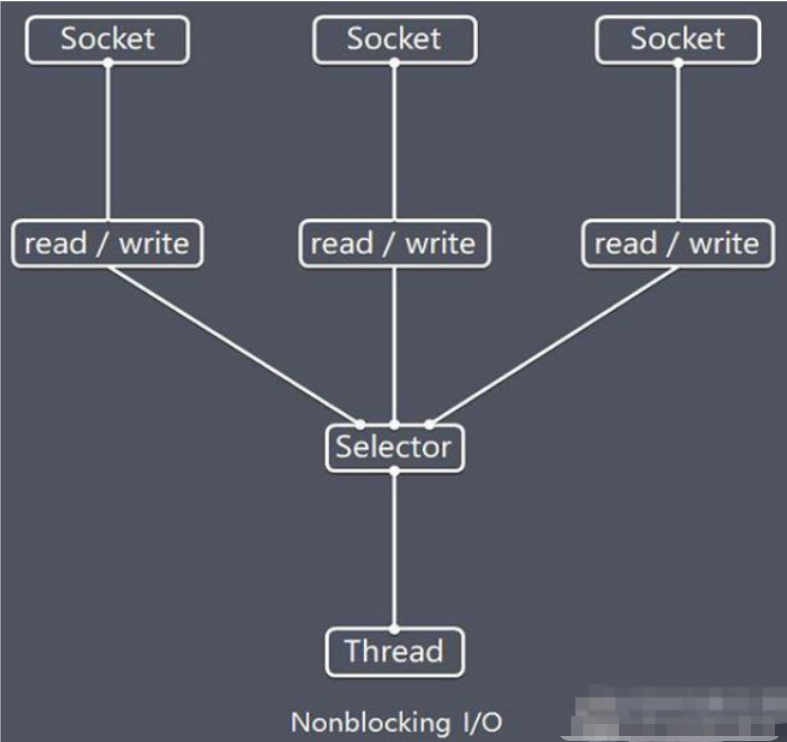
- Netty 的 IO 线程 NioEventLoop 聚合了 Selector(选择器,也叫多路复用器),可以同时并发处理成百上千个客户端连接。
- 当线程从某客户端 Socket 通道进行读写数据时,若没有数据可用时,该线程可以进行其他任务。
- 线程通常将非阻塞 IO 的空闲时间用于在其他通道上执行 IO 操作,所以单独的线程可以管理多个输入和输出通道。
- 由于读写操作都是非阻塞的,这就可以充分提升 IO 线程的运行效率,避免由于频繁 I/O 阻塞导致的线程挂起。
- 一个 I/O 线程可以并发处理 N 个客户端连接和读写操作,这从根本上解决了传统同步阻塞 I/O 一连接一线程模型,架构的性能、弹性伸缩能力和可靠性都得到了极大的提升。
Selector 类是一个抽象类, 常用方法和说明如下:

1、NIO 中的 ServerSocketChannel 功能类似 ServerSocket,SocketChannel 功能类似 Socket
2、Selector 相关方法说明
- selector.select()//阻塞
- selector.select(1000);//阻塞 1000 毫秒,在 1000 毫秒后返回
- selector.wakeup();//唤醒 selector
- selector.selectNow();//不阻塞,立马返还

对上图的说明:
- 当客户端连接时,会通过 ServerSocketChannel 得到 SocketChannel
- Selector 进行监听 select 方法, 返回有事件发生的通道的个数.
- 将 socketChannel 注册到 Selector 上, register(Selector sel, int ops), 一个 selector 上可以注册多个 SocketChannel
- 注册后返回一个 SelectionKey, 会和该 Selector 关联(集合)
- 进一步得到各个 SelectionKey (有事件发生)
- 在通过 SelectionKey 反向获取 SocketChannel , 方法 channel()
- 可以通过 得到的 channel , 完成业务处理
代码:
NIOServer:服务器
package com.sun.netty.Selector; import java.net.InetSocketAddress; import java.nio.ByteBuffer; import java.nio.channels.*; import java.util.Iterator; import java.util.Set; /** * @Author: sunguoqiang * @Description: TODO * @DateTime: 2022/12/21 17:06 **/ public class NIOServer { public static void main(String[] args) throws Exception { // 1、创建ServerSocketChannel对象 ServerSocketChannel serverSocketChannel = ServerSocketChannel.open(); // 2、创建Selector对象 Selector selector = Selector.open(); // 3、绑定端口 serverSocketChannel.bind(new InetSocketAddress(8989)); // 4、配置ServerSocketChannel为非阻塞 serverSocketChannel.configureBlocking(false); // 5、绑定ServerSocketChannel到Selector serverSocketChannel.register(selector, SelectionKey.OP_ACCEPT); // 6、循环接收客户端消息 while (true) { if (selector.select(60000) == 0) { System.out.println("等待60秒钟无连接..."); continue; } // 如果返回的>0, 就获取到相关的 selectionKey 集合 // 1.如果返回的>0, 表示已经获取到关注的事件 // 2. selector.selectedKeys() 返回关注事件的集合 // 通过 selectionKeys 反向获取通道 Set<SelectionKey> selectionKeys = selector.selectedKeys(); // 遍历 Set<SelectionKey>, 使用迭代器遍历 Iterator<SelectionKey> iterator = selectionKeys.iterator(); while (iterator.hasNext()) { // 获取到 SelectionKey SelectionKey selectionKey = iterator.next(); // 根据 key 对应的通道发生的事件做相应处理 if (selectionKey.isAcceptable()) { // 如果是 OP_ACCEPT, 有新的客户端连接 // 该客户端生成一个 SocketChannel SocketChannel socketChannel = serverSocketChannel.accept(); System.out.println("服务器端连接上一个请求:" + socketChannel.hashCode()); // 将 SocketChannel 设置为非阻塞 socketChannel.configureBlocking(false); // 将 socketChannel 注册到 selector, 关注事件为 OP_READ, 同时给 socketChannel // 关联一个 Buffer socketChannel.register(selector, SelectionKey.OP_READ, ByteBuffer.allocate(1024)); } if (selectionKey.isReadable()) { // 发生 OP_READ // 通过 key 反向获取到对应 channel SocketChannel socketChannel = (SocketChannel) selectionKey.channel(); // 获取到该 channel 关联的 buffer ByteBuffer buffer = (ByteBuffer) selectionKey.attachment(); buffer.clear(); socketChannel.read(buffer); if (buffer.capacity() - buffer.remaining() == 0) { System.out.println("客户端:" + socketChannel.hashCode() + "断开连接..."); } else { System.out.println("来自客户端" + socketChannel.hashCode() + "的消息:" + new String(buffer.array(), 0, buffer.capacity() - buffer.remaining())); } } // 手动从集合中移动当前的 selectionKey, 防止重复操作 iterator.remove(); } } } }复制
NIOClient:客户端
package com.sun.netty.Selector; import java.net.InetSocketAddress; import java.nio.ByteBuffer; import java.nio.channels.SocketChannel; /** * @Author: sunguoqiang * @Description: TODO * @DateTime: 2022/12/21 17:57 **/ public class NIOClient { public static void main(String[] args) throws Exception { //得到一个网络通道 SocketChannel socketChannel = SocketChannel.open(); //设置非阻塞 socketChannel.configureBlocking(false); //提供服务器端的 ip 和 端口 InetSocketAddress inetSocketAddress = new InetSocketAddress("127.0.0.1", 8989); //连接服务器 if (!socketChannel.connect(inetSocketAddress)) { while (!socketChannel.finishConnect()) { System.out.println("因为连接需要时间,客户端不会阻塞,可以做其它工作.."); } } //...如果连接成功,就发送数据 String str = "hello, 阿昌~"; //Wraps a byte array into a buffer ByteBuffer buffer = ByteBuffer.wrap(str.getBytes()); //发送数据,将 buffer 数据写入 channel socketChannel.write(buffer); System.in.read(); } }复制
1、SelectionKey,表示 Selector 和网络通道的注册关系
int OP_ACCEPT:有新的网络连接可以 accept,值为 16
int OP_CONNECT:代表连接已经建立,值为 8
int OP_READ:代表读操作,值为 1
int OP_WRITE:代表写操作,值为 4
源码中:
public static final int OP_READ = 1 << 0; public static final int OP_WRITE = 1 << 2; public static final int OP_CONNECT = 1 << 3; public static final int OP_ACCEPT = 1 << 4;复制
2、SelectionKey 相关方法
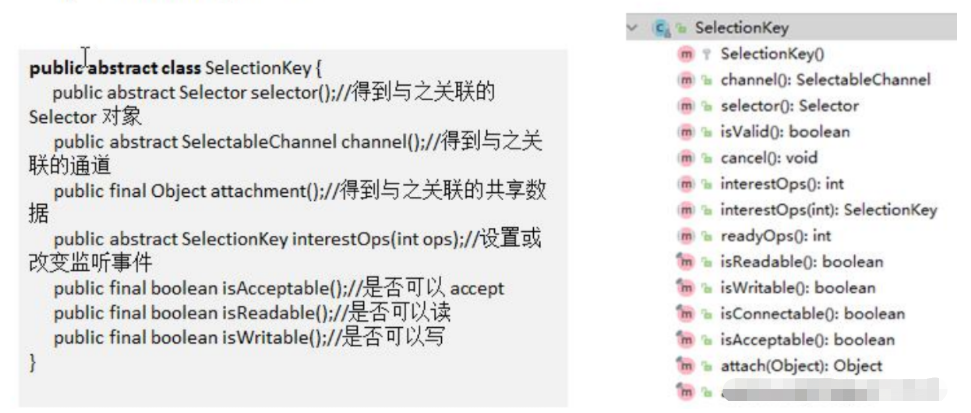
ServerSocketChannel 在服务器端监听新的客户端 Socket 连接
专门负责监听新的客户端,获取对应的SocketChannel

SocketChannel,网络 IO 通道,具体负责进行读写操作。
NIO 把缓冲区的数据写入通道,或者把通道里的数据读到缓冲区。

实例要求:
1、编写一个 NIO 群聊系统,实现服务器端和客户端之间的数据简单通讯(非阻塞)
2、实现多人群聊
3、服务器端:可以监测用户上线,离线,并实现消息转发功能
4、客户端:通过 channel 可以无阻塞发送消息给其它所有用户,同时可以接受其它用户发送的消息(有服务器转发得到)
5、目的:进一步理解 NIO 非阻塞网络编程机制
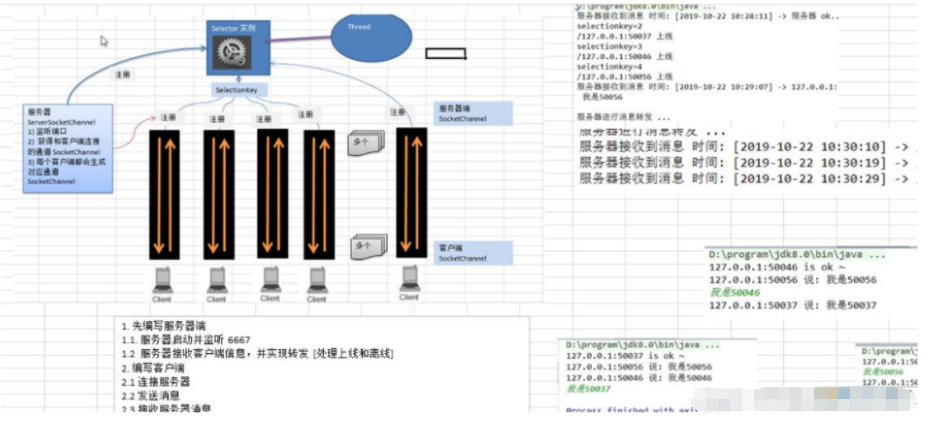
代码:
服务器端
package com.sun.netty.GroupChat; import java.io.IOException; import java.net.InetSocketAddress; import java.nio.ByteBuffer; import java.nio.channels.*; import java.util.Iterator; /** * 群聊服务器端 * 1、消息接收、转发 * 2、上线、离线提醒 */ public class GroupChatServer { // 定义全局变量 private ServerSocketChannel serverSocketChannel; private Selector selector; private static final int PORT = 9999; // 构造方法初始化 public GroupChatServer() { try { serverSocketChannel = ServerSocketChannel.open(); serverSocketChannel.configureBlocking(false); serverSocketChannel.bind(new InetSocketAddress(PORT)); selector = Selector.open(); serverSocketChannel.register(selector, SelectionKey.OP_ACCEPT); } catch (IOException e) { e.printStackTrace(); } } // 监听方法 public void listen() { try { while (true) { int selectCount = selector.select(); if (selectCount > 0) { Iterator<SelectionKey> selectionKeyIterator = selector.selectedKeys().iterator(); while (selectionKeyIterator.hasNext()) { SelectionKey selectionKey = selectionKeyIterator.next(); if (selectionKey.isAcceptable()) { SocketChannel socketChannel = serverSocketChannel.accept(); socketChannel.configureBlocking(false); socketChannel.register(selector, SelectionKey.OP_READ); System.out.println(socketChannel.getRemoteAddress() + ":已上线..."); } if (selectionKey.isReadable()) { readData(selectionKey); } } // 注意点!!! selectionKeyIterator.remove(); } else { System.out.println("服务端等待连接..."); } } } catch (IOException e) { e.printStackTrace(); } finally { // 省略 } } private void readData(SelectionKey selectionKey) { SocketChannel socketChannel = null; try { socketChannel = (SocketChannel) selectionKey.channel(); ByteBuffer buffer = ByteBuffer.allocate(1024); int read = socketChannel.read(buffer); if (read > 0) { String msg = new String(buffer.array()); System.out.println("来自客户端[" + socketChannel.getRemoteAddress() + "]:" + msg); transferToOtherClient(selectionKey, msg); } } catch (IOException e) { try { System.out.println("客户端[" + socketChannel.getRemoteAddress() + "]:离线了..."); selectionKey.cancel(); socketChannel.close(); } catch (IOException ioException) { ioException.printStackTrace(); } } } private void transferToOtherClient(SelectionKey selectionKey, String msg) throws IOException { System.out.println("服务器正在转发消息..."); Iterator<SelectionKey> iterator = selector.keys().iterator(); SocketChannel senderChannel = (SocketChannel) selectionKey.channel(); while (iterator.hasNext()) { SelectionKey key = iterator.next(); Channel channel = key.channel(); if (channel instanceof SocketChannel && key != selectionKey) { SocketChannel receiveSocketChannel = (SocketChannel) key.channel(); ByteBuffer byteBuffer = ByteBuffer.wrap(msg.getBytes()); receiveSocketChannel.write(byteBuffer); } } } public static void main(String[] args) { GroupChatServer groupChatServer = new GroupChatServer(); groupChatServer.listen(); } }复制
客户端
package com.sun.netty.GroupChat; import java.io.IOException; import java.net.InetSocketAddress; import java.nio.ByteBuffer; import java.nio.channels.SelectionKey; import java.nio.channels.Selector; import java.nio.channels.SocketChannel; import java.util.Iterator; import java.util.Scanner; public class GroupChatClient { private static final String ip = "127.0.0.1"; private static final int PORT = 9999; private SocketChannel channel; private Selector selector; private String username; public GroupChatClient() { try { channel = SocketChannel.open(new InetSocketAddress(ip, PORT)); channel.configureBlocking(false); selector = Selector.open(); channel.register(selector, SelectionKey.OP_READ); username = channel.getLocalAddress().toString(); System.out.println(username + ":上线成功..."); } catch (IOException e) { e.printStackTrace(); } } public void sendMsg(String msg) { // 注意点!!! msg = username + ":" + msg; try { channel.write(ByteBuffer.wrap(msg.getBytes())); } catch (IOException e) { e.printStackTrace(); } } public void getMsg() { try { int selectCount = selector.select(); if (selectCount > 0) { Iterator<SelectionKey> iterator = selector.selectedKeys().iterator(); while (iterator.hasNext()) { SelectionKey key = iterator.next(); if (key.isReadable()) { SocketChannel channel = (SocketChannel) key.channel(); ByteBuffer byteBuffer = ByteBuffer.allocate(1024); channel.read(byteBuffer); System.out.println(new String(byteBuffer.array()).trim()); } } iterator.remove(); } } catch (IOException e) { e.printStackTrace(); } } public static void main(String[] args) { GroupChatClient client = new GroupChatClient(); new Thread(() -> { while (true) { client.getMsg(); try { Thread.currentThread().sleep(3000); } catch (Exception e) { e.printStackTrace(); } } }).start(); Scanner scanner = new Scanner(System.in); while (scanner.hasNextLine()) { String next = scanner.nextLine(); client.sendMsg(next); } } }复制
涉及计算机系统底层,如果想要详细了解请点击此处查看相关pdf。零拷贝原理
1、JDK 7 引入了 Asynchronous I/O,即 AIO。在进行 I/O 编程中,常用到两种模式:Reactor 和 Proactor。
2、Java 的NIO 就是 Reactor,当有事件触发时,服务器端得到通知,进行相应的处理
3、AIO 即 NIO2.0,叫做异步不阻塞的 IO。
4、AIO 引入异步通道的概念,采用了 Proactor 模式,简化了程序编写,有效的请求才启动线程,它的特点是先由操作系统完成后才通知服务端程序启动线程去处理,一般适用于连接数较多且连接时间较长的应用 目前 AIO 还没有广泛应用,Netty 也是基于 NIO,而不是 AIO, 因此我们就不详解 AIO 了
5、有兴趣可参考 <<Java 新 一 代 网 络 编 程 模 型 AIO 原 理 及 Linux 系 统 AIO 介 绍 >> http://www.52im.net/thread-306-1-1.html
